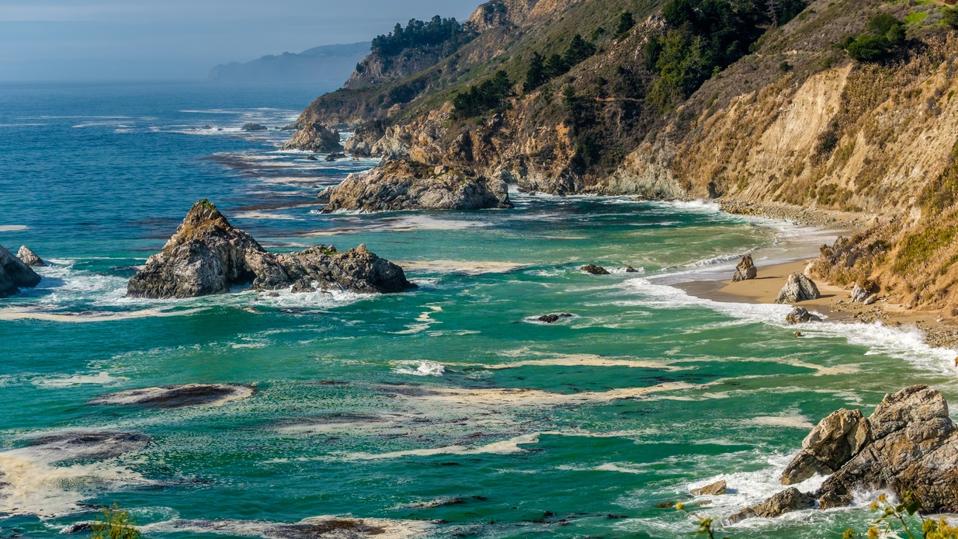Home to towering mountains, verdant forests and dramatic seaside cliffs, California offers a staggering range of landscapes to explore—and as an added bonus, each one is brimming with a unique array of flora and fauna. From the arid reaches of San Diego County to the redwood-filled northern coast, this scenic state plays host to a wealth of captivating mammals, birds and plants, many of which are endemic to the region. If you’re planning an all-out ecotourism getaway across the Golden State, don’t miss out on the following parks, each one offering its own perspective on the abundant beauty of the western United States.
Julia Pfeiffer Burns State Park
Considered one of the crown jewels of California’s Highway 1, Julia Pfeiffer Burns State Park is an essential stop on any coastal California road trip. While the refuge is best known for McWay Falls—an 80-foot waterfall that spills directly onto the sandy beach below—those who venture into the interior of the park will be richly rewarded with wildlife sightings, with more than 100 bird species recorded across the surrounding area. During a trek along Ewoldsen Trail, explorers can spot forest-dwelling birds like the Allen’s hummingbird and Wilson’s warbler, while those who stick to the coastline can keep an eye out for pigeon guillemots, pelagic cormorants and even the occasional California condor.
Anza-Borrego Desert State Park
Roughly 90 minutes east of San Diego, Anza-Borrego Desert State Park wows visitors with its vast swathes of desert and diverse array of plant species. Upon arrival, guests can marvel at indigenous flora like the desert fan palm—California’s sole native palm tree—as well as eye-catching cacti like the beavertail pricklypear and silver cholla. In terms of avifauna, the region brims with iconic desert wildlife like the greater roadrunner and phainopepla, while golden eagles can occasionally be spotted soaring high above the park in search of prey. Beyond birds, Anza-Borrego also earns recognition for its many bighorn sheep, while resident predatory mammals span from the mountain lion to the gray fox.
Henry Cowell Redwoods State Park
Formally established in 1953, Henry Cowell Redwoods State Park showcases the timeless beauty of California’s Santa Cruz Mountains, with flowing creeks and vast swathes of coast redwood forest. The preserve’s native plantlife serves as the primary draw for tourists, with a 40-acre grove of old-growth redwoods as well as a lengthy stand of Ponderosa pine—but it’s not just flora that thrives within park limits. Animals abound across the surrounding mountains, providing an opportunity for hikers to catch a glimpse of creatures like the mule deer and bobcat, while birdwatchers can keep their eyes peeled for the occasional California scrub jay or varied thrush.
Point Lobos State Natural Reserve
Renowned for its high degree of biodiversity, Point Lobos State Natural Reserve offers a fascinating blend of both marine and terrestrial ecosystems, with dense kelp forests and multiple Monterey cypress stands found within its borders. During a visit, wildlife aficionados can keep their eyes on the shoreline to spot harbor seals and California sea lions, while lucky visitors might catch a glimpse of a gray whale during their migration season. Meanwhile, history buffs can gain insight into the recent past of Point Lobos with a trip to the Whalers Cabin Museum, an 1850s-era structure that was used as lodging for Chinese fishers during the mid-20th century.
Calaveras Big Trees State Park
True to its name, Calaveras Big Trees State Park is a top spot for strolling beneath California’s famed giant sequoias, with close to 6,500 acres of verdant forest to explore during a visit. While trees are certainly the main attraction around here, the preserve also plays host to plenty of native avian species, drawing birdwatchers to scope out colorful creatures like the white-headed woodpecker, golden-crowned kinglet and chestnut-backed chickadee—and while there’s plenty to explore on dry land, fishing aficionados can also make use of the park’s stretch of the Stanislaus River, a lengthy tributary that harbors a variety of different trout species.

